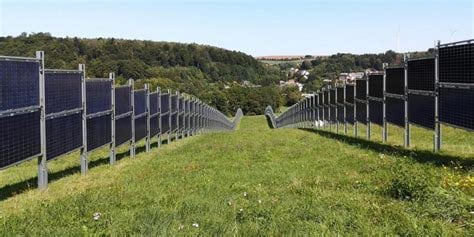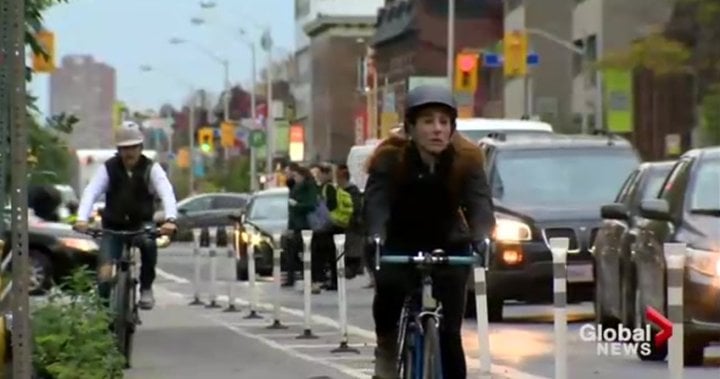embedded machine learning research engineer - georgist - urbanist - environmentalist
- 108 Posts
- 336 Comments

 34·4 months ago
34·4 months agoAnd things like vertical bifacial solar panels can work especially amazingly on grazing land that isn’t suitable for crops.

Counter-intuitive as they may look, they actually have a number of benefits:
- The panels face east and west, meaning they generate peak power in the morning and evening, which corresponds to peak demand => less need for energy storage to bridge the gap between the mid-day peak in production from traditional PV and the aforementioned morning and evening demand peaks.
- The panels are vertical, which makes them easier and cheaper to maintain, as dust, snow, and rain naturally shed from their surfaces.
- The panels get less direct energy during mid-day, keeping their surfaces cooler. Turns out cooler solar panels are more efficient at converting light energy into electrical energy.
- The arrangement lends itself very naturally to agrivoltaics, which means you can derive more yields from a given piece of land and use less land overall than if you had segregated uses.
- The compatibility with agrivoltaics allows farmers to diversify their incomes streams and/or become energy self-sufficient.

 9·5 months ago
9·5 months agoThe problem is tons of free parking everywhere needlessly sprawls out our cities, makes people drive further, and makes actual green methods of transit (like walking, cycling, and electrified public transit) less viable.
In the long term, maintaining car dependency is fundamentally incompatible with addressing the climate crisis. Removing mandatory parking minimums is a necessary step towards ending car dependency.

Silvopasture is an ancient practice that integrates trees and pasture into a single system for raising livestock. Pastures with trees sequester five to 10 times as much carbon as those of the same size that are treeless while maintaining or increasing productivity and providing a suite of additional benefits. Livestock continue to emit the greenhouse gases methane and nitrous oxide, but these are more than offset by carbon sequestration, at least until soil carbon saturation is achieved.
Silvopasture also offer financial benefits for farmers and ranchers. Livestock, trees, and other forest products, such as nuts, fruit, and mushrooms, generate income on different time horizons. And help protect farmers from risk. The health and productivity of both animals and the land improve.
https://drawdown.org/solutions/silvopasture
Trees in silvopasture systems provide livestock with protection from sun and wind, which can increase animal comfort and improve production. Trees can provide shade in the summer and windbreaks in the winter, allowing livestock to moderate their own temperature. Heat stress in livestock has been associated with decreased feed intake, increased water intake, and negative effects on production, reproductive health, milk yields, fitness, and longevity.[4][5]
Certain tree types can also serve as fodder for livestock. Trees may produce fruit or nuts that can be eaten by livestock while still on the tree or after they have fallen. The leaves of trees may serve as forage as well, and silvopasture managers can utilize trees as forage by felling the tree so that it can be eaten by livestock, or by using coppicing or pollarding to encourage leaf growth where it is accessible to livestock.[1]
Well-managed silvopasture systems can produce as much forage as open-pasture systems under favorable circumstances. Silvopasture systems have also been observed to produce forage of higher nutritive quality than non-silvopasture forage under certain conditions. Increased forage availability has been observed in silvopasture systems compared to open-pasture systems under drought conditions, where the combination of shade from trees and water uptake from tree roots may reduce drought impacts.[1]

 131·5 months ago
131·5 months agoExactly. I’m just trying to reframe dumb NIMBY policies like restrictive zoning and mandatory parking minimums as anti-freedom so as to try to get conservative NIMBYs to maybe be just a little less NIMBY.
Absolutely no one is seriously arguing we allow PFAS chemical plants next to kindergartens or that we remove all building safety codes. Just that restrictive zoning (and other NIMBY land use policies) is stupid, harmful, and we should get rid of it.

 12·5 months ago
12·5 months agoThe right to a bicycle shall not be infringed

 4·6 months ago
4·6 months agojust a frame, a chain,
two wheels, and grease

 10·6 months ago
10·6 months agoKinda tempts me to photoshop a RAM PRIDE or FORD PRIDE ad for pride month

 79·6 months ago
79·6 months agoExcellent point, brother. Always choose AMERICAN MUSCLE over COMMIE OIL.

 9·6 months ago
9·6 months agoThe raison d’être for RISC-V is domain-specific architecture. Currently, computational demands are growing exponentially (especially with AI), but Moore’s Law is ending, which means we can no longer meet our computational demands by scaling single-core speed on general-purpose CPUs. Instead, we are needing to create custom architectures for handling particular computational loads to eke out more performance. Things like NPUs, TPUs, etc.
The trouble is designing and producing these domain-specific architectures is expensive af, especially given the closed-source nature of computer hardware at the moment. And all that time, effort, and money just to produce a niche chip used for a niche application? The economics don’t economic.
But with an open ISA like RISC-V, it’s both possible and legal to do things like create an open-source chip design and put it on GitHub. In fact, several of those exist already. This significantly lowers the costs of designing domain-specific architectures, as you can now just fork an existing chip and make some domain-specific modifications/additions. A great example of this is PERCIVAL: Open-Source Posit RISC-V Core with Quire Capability. You could clone their repo and spin up their custom RISC-V posit chip on an FPGA today if you wanted to.

 111·6 months ago
111·6 months agoYeah, this is the one piece a lot of people miss: in any decently competitive market, individual firms have effectively zero power to set prices; they must instead accept the prices determined by the market.
Knowing that, the solution to that sort of corporate BS, then, is to ensure markets are competitive by busting monopolies, lowering barriers to entry, and getting money out of politics to reduce the effect of lobbying.

 6·6 months ago
6·6 months agoThat’s actually the neat thing about land value taxes; both in economic theory and observed practice, they can’t be passed on to tenants.
It would absolutely be a boon for the poor if we replaced other forms of taxation (such as on sales and income) with land value taxes. Plus, land value taxes tend to make housing cheaper, which helps the poor as well.

 131·7 months ago
131·7 months agoExactly. People love to treat it as “a war on cars/lawns/etc.”, but it’s really a war on everybody who doesn’t want to be legally mandated to have those. All we’re asking for is to end the legal mandates (zoning, parking minimums, setback requirements, etc.) and for those who wish to partake in those wasteful luxuries to pay their true price without public subsidy.

 13·7 months ago
13·7 months agoTbh, my favorite kind of gardening is the kind that thrives on neglect. I love making ecosystems that thrive on their own, without my constant input. There’s just something beautiful about seeing life thrive on its own.

 1·7 months ago
1·7 months agoIt’s not, though. The classical factors of production, whence we get the concept of “capital” as a factor of production, has land and capital as clearly separate:
Land or natural resource — naturally occurring goods like water, air, soil, minerals, flora, fauna and climate that are used in the creation of products. The payment given to a landowner is rent, loyalties, commission and goodwill.
Labor — human effort used in production which also includes technical and marketing expertise. The payment for someone else’s labor and all income received from one’s own labor is wages. Labor can also be classified as the physical and mental contribution of an employee to the production of the good(s).
Capital stock — human-made goods which are used in the production of other goods. These include machinery, tools, and buildings. They are of two types, fixed and working. Fixed are one time investments like machines, tools and working consists of liquid cash or money in hand and raw material.
https://en.m.wikipedia.org/wiki/Factors_of_production
And it’s an important distinction. The fact that land is not made and inherently finite makes it zero-sum. Meanwhile, the fact that capital such as education, tools, factories, infrastructure, etc. are man-made and not inherently finite makes them not zero-sum. This distinction has truly massive implications when it comes to economics and policymaking. It’s the whole reason LVT is so effective, so efficient, and so fair: it exploits the unique zero-sum nature of land.

 2·7 months ago
2·7 months agoI got a positive one for you


 2·7 months ago
2·7 months agoYou might like single transferrable vote (STV), then. You have districts with several seats in them (preferably ~5), and then do a ranked-choice ballot to select the candidates who will fill those seats. Key advantages over proportional representation are that it maintains the idea of a constituency and that it maintains voting for individual candidates, not just parties.
Downside, of course, is that it’s not as proportional as proportional representation, but it still achieves pretty proportional results. That’s the tradeoff for maintaining constituencies and individual candidates.

 9·7 months ago
9·7 months agoProperty taxes != Land value taxes
Further, it’s not a tax on capital; it’s a tax on land. It’s very explicitly designed to target land, as land has distinct economic properties that make it a prime target for taxation.
And yes, it does target speculative investments like those of Blackrock:
It reveals that much of the anticipated future tax obligations appear to have been already capitalised into lower land prices. Additionally, the tax transition may have also deterred speculative buyers from the housing market, adding even further to the recent pattern of low and stable property prices in the Territory. Because of the price effect of the land tax, a typical new home buyer in the Territory will save between $1,000 and $2,200 per year on mortgage repayments.






Some squatter who bought the rights to it for two twigs and a raspberry back when they were first selling off name rights 200,000 years ago